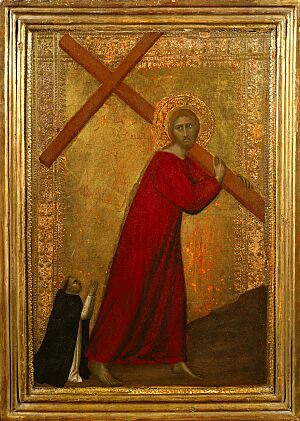Barna da Siena facts for kids
Barna da Siena, sometimes called Berna di Siena, was a painter from Siena, Italy. He was active around the years 1330 to 1350. Not much is known for sure about him. Some art experts even think he might not have been a real person.
Two famous art historians, Lorenzo Ghiberti and Giorgio Vasari, wrote about a painter named Barna or Berna. Ghiberti mentioned him in his book I Commentarii. He said Barna painted many stories from the Old Testament in a town called San Gimignano. Vasari also wrote about him in his book, Lives of the Most Excellent Painters, Sculptors, and Architects. Vasari first said Barna painted Old Testament scenes. Later, he changed his mind and said Barna painted New Testament scenes in the Collegiata di San Gimignano church.
Today, many experts believe the paintings in San Gimignano were done by several different artists. The style and quality of the paintings vary a lot. Also, the dates Vasari gave for the New Testament scenes seem wrong. Experts now think these paintings were made earlier, between 1330 and 1340. Because of these mysteries, many scholars think "Barna" might be a made-up name for a group of artists. These artists likely followed the style of Simone Martini and Lippo Memmi.
Who was Barna da Siena?
Since there are no signed artworks by Barna, he is known as the master of the Collegiata di San Gimignano. It is thought that his student, Giovanni d'Asciano, helped him with the frescoes. Giovanni might have finished the work after Barna supposedly fell from a scaffolding and died young.
Some ideas, based on Giorgio Vasari's writings, suggest the master in San Gimignano was named Bernardo Bertini. Bernardo was captured in 1335 during a fight. He later went to Siena and studied art. Records show that by 1355, he was either gone from Siena or had died. This supports the idea that Barna died fairly young, perhaps around 1360. If he was born shortly before 1320, he would have been less than 40 when he died.
What was Barna's painting style like?
Even though we don't know much about Barna's life, his paintings have a very clear style. He was known for making his figures look very dramatic and emotional. He often used a "close-in" style, showing fewer figures than other painters of his time.
For example, in his painting The Raising of Lazarus, Barna shows fewer people than another artist named Duccio. Barna focused more on the feelings and actions of each person. Their faces show strong emotions. This human-like feeling was new for Sienese painters before him. Barna seemed to ignore the older, more formal styles. Instead, his figures looked solid and full of emotion. This style reminds experts of painters from Florence, like Lorenzetti. This makes some people think Barna might have been from Florence, not Siena.
See also
 In Spanish: Barna da Siena para niños
In Spanish: Barna da Siena para niños



